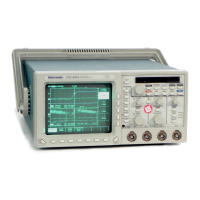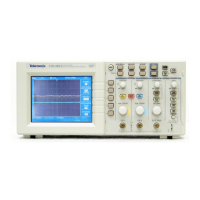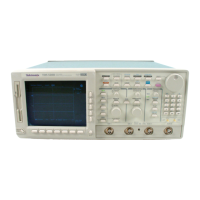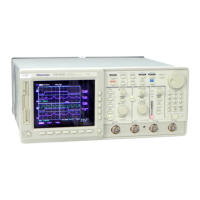Pulse Triggering
TDS 420A, TDS 430A, TDS 460A & TDS 510A User Manual
3–93
To specify which channel becomes the pulse trigger source:
Press TRIGGER MENU
➞ Type (main) ➞ Pulse (pop-up) ➞
Source
(main) ➞ Ch1, Ch2, Ch3, or Ch4 (side).
To change the holdoff time and select the trigger mode:
Press TRIGGER MENU
➞ Type (main) ➞ Pulse (pop-up) ➞ Mode and
Holdoff
(main) ➞ Auto or Normal (side). See To Set Mode and Holdoff, on
page 3–24, for more information.
Glitch Operations
When you select the pulse class Glitch, the oscilloscope will trigger on a pulse
narrower (or wider) in width than some specified time.
To define the glitch in terms of polarity (positive, negative, or either) and width:
1. Press TRIGGER MENU
➞ Type (main) ➞ Pulse (pop-up) ➞ Polarity
and Width
(main) ➞ Positive, Negative, or Either (side).
Glitch Positive looks at positive-going pulses.
Glitch Negative looks at negative-going pulses.
Glitch Either looks at both positive and negative pulses.
2. Press Width
(side), and set the glitch width using the general purpose knob
or keypad.
To specify whether to trigger on glitches or filter out glitches using the Glitch
main menu item, press TRIGGER MENU
➞ Type (main) ➞ Pulse (pop-up) ➞
Class
(main) ➞ Glitch (pop-up) ➞ Glitch (main) ➞ Accept Glitch or Reject
Glitch
(side).
If you choose Accept Glitch, the oscilloscope will trigger only on pulses
narrower than the width you specified. If you select Reject Glitch, it will trigger
only on pulses wider than the specified width.
To set the trigger level with the Level main menu (or the front panel trigger
LEVEL knob), press TRIGGER MENU
➞ Type (main) ➞ Pulse (pop-up) ➞
Level
(main) ➞ Level, Set to TTL, Set to ECL, or Set to 50% (side). See To
Set Level, on page 3–93, for more information.
Source
Mode & Holdoff
Polarity & Width
Glitch (Accept or Reject)
Level

